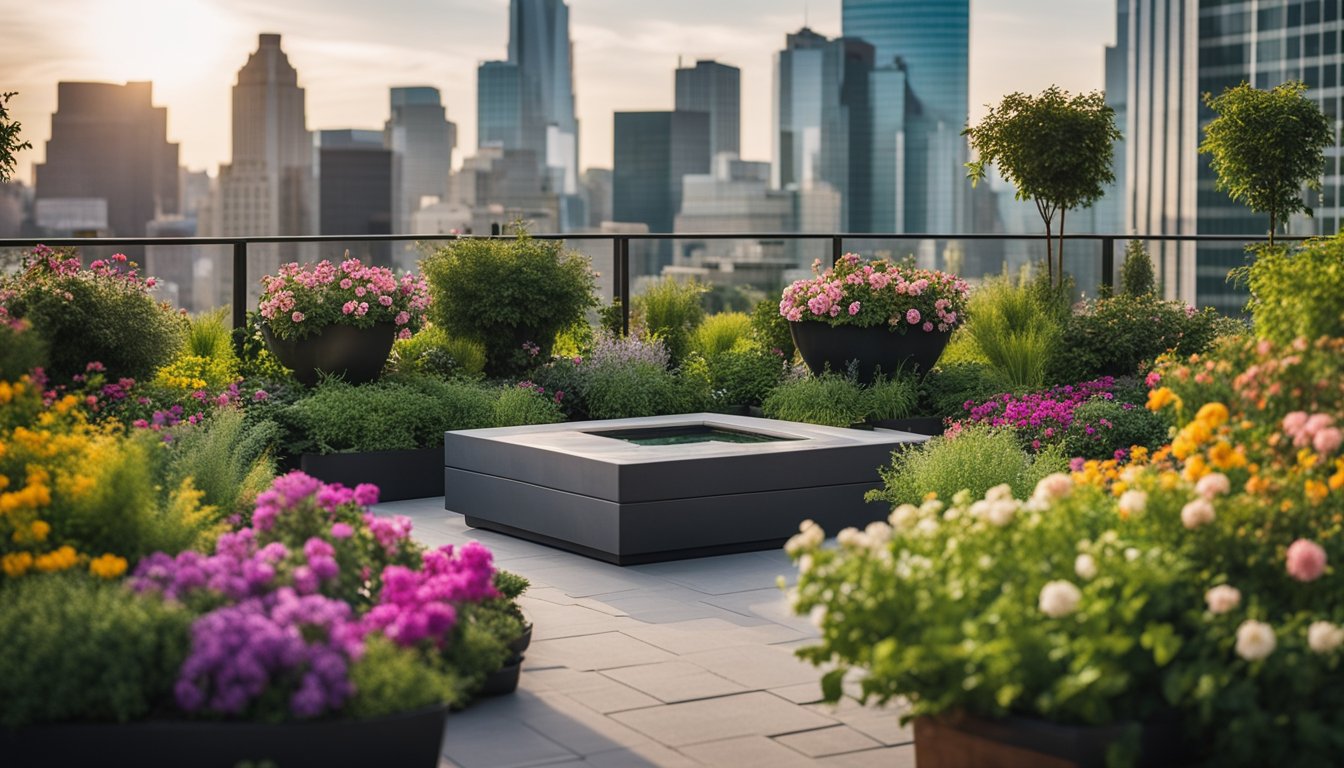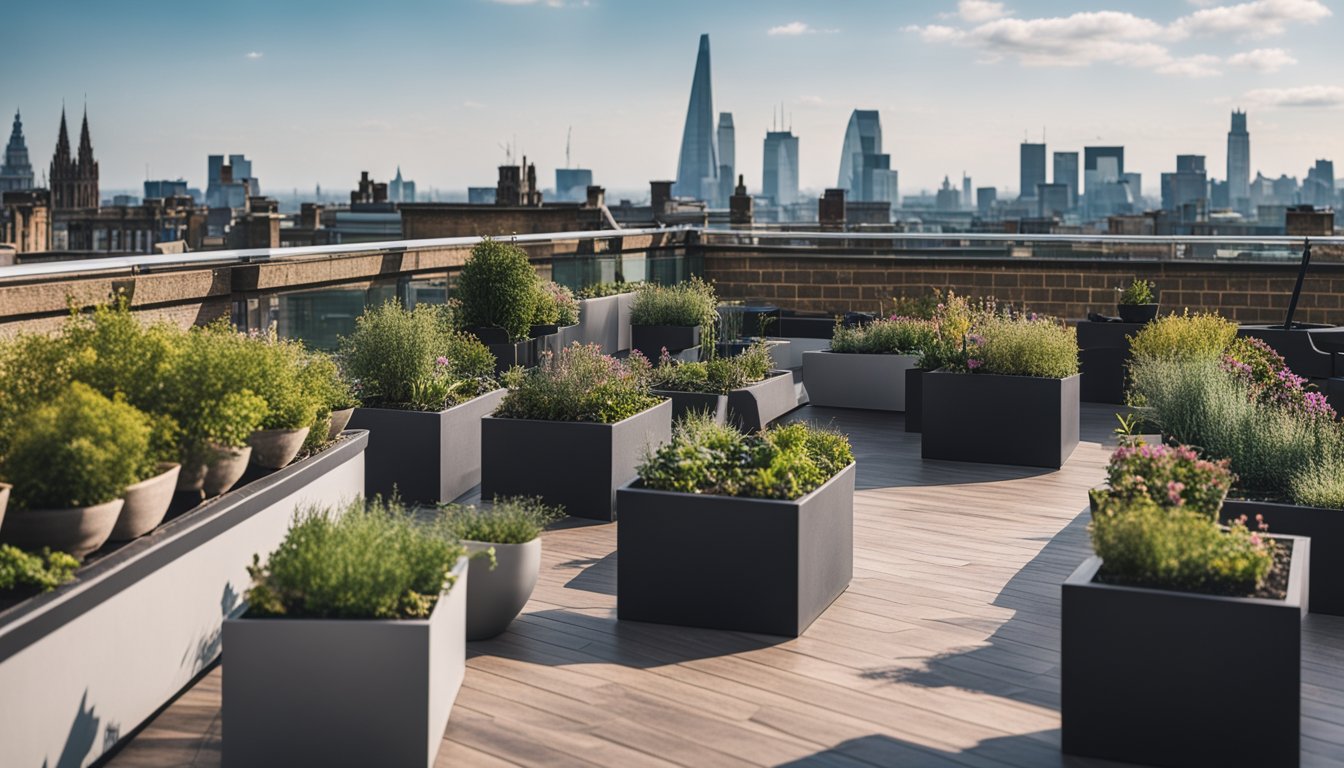Late updated: 15 Jul 2024 10:07
Written by: Oliver Bennett
Rooftop Garden Ideas For UK Homes: Sustainable Designs and Tips
In urban areas, particularly throughout the UK, creating a rooftop garden is an excellent way to maximise your outdoor living space. Whether you're considering an urban jungle, a cosy chill-out zone, or a minimalist terrace, these green spaces not only provide a personal sanctuary but also enhance the surrounding views. Our goal is to help you design a roof garden that complements your home, improves air quality, and offers a retreat from the city's hustle and bustle.

Planning your rooftop garden involves selecting the right mix of materials and plants to ensure year-round interest. It's essential to consider the structural capacity of your roof, the local climate, and the type of plants best suited to your environment. With a little creativity and practical know-how, transforming an unused rooftop into a thriving garden is entirely achievable.
From incorporating vertical gardens to choosing lightweight, weather-resistant furniture, there's no shortage of ideas to customise your space. By thoughtfully selecting plant varieties and design elements, we can extend our living areas and create a unique green oasis above the streets of the UK.
Key Takeaways
- Rooftop gardens maximise outdoor living space in UK homes.
- Proper planning includes considering roof structure, climate, and plant suitability.
- Creativity in design can transform an unused rooftop into a thriving garden.
Planning Your Rooftop Garden

Creating a rooftop garden involves careful consideration of space, structural integrity, material selection, and climate adaptation. These key elements ensure the garden is both functional and aesthetically pleasing.
Assessing Space and Structural Requirements
Before starting any design work, we need to assess the available space and understand the structural requirements of our rooftop. Consulting a structural engineer is crucial to determine the load-bearing capacity of the building. This step ensures we don't overload the roof with too much weight from soil, plants, and garden features.
Weight restrictions vary depending on whether we have a flat roof or an inclined one. It's essential to use lightweight materials and opt for raised beds or containers to distribute the weight evenly. We should also consider the location of access points like doors or staircases to ensure easy and safe movement.
Choosing the Right Materials and Plants
Selecting the right materials and plants is vital for the success of our garden. We'll need materials that can withstand various weather conditions while complementing the overall design. For hard landscaping, options like lightweight pavers, composite decking, and weather-resistant furniture are excellent choices.
When it comes to plants, we should choose species that can thrive in the rooftop environment. Hardy perennials, drought-resistant plants, and evergreens are ideal for providing year-round interest. Incorporating raised beds filled with a suitable soil mix will support healthy plant growth while managing weight. Additionally, we should install an efficient irrigation system to ensure plants receive adequate water without overwhelming the roof with excess moisture.
Designing for Weather and Privacy
Rooftop gardens require specific design considerations to address weather challenges and privacy concerns. The higher elevation can mean stronger winds, which may damage plants or infrastructure. Adding windbreaks, such as trellises or robust shrubs, helps mitigate this issue.
Providing shade through pergolas or umbrellas can protect plants and create comfortable seating areas. Privacy is another important factor, especially in urban settings. Tall plants, screens, or partitions can serve as visual barriers, offering a secluded retreat amid the bustling city. Ensuring these design elements are strategically placed and secure will enhance the garden's functionality and comfort.
By approaching these aspects thoughtfully, we can transform our rooftop into a thriving, beautiful garden space.
Creating Your Rooftop Oasis

Transforming our rooftop into a green retreat can elevate our living space, offering peace and beauty. Let's explore the key elements, like layered planting and container gardening, furnishing and decorating the space, and maintaining our rooftop garden.
Layered Planting and Container Gardening
Layering plants is essential in creating a lush and diverse rooftop garden. By using a mix of planters and pots at different heights, we can create a cascading effect that draws the eye. Consider incorporating evergreens, like pines and olive trees, which provide a constant backdrop.
Container gardening is particularly effective on rooftops due to limited space. Opt for hardy, drought-resistant plants such as lavender and santolina, which thrive in the UK climate. Using high-quality soil and compost ensures healthy growth. An irrigation system can also simplify watering, making it manageable even during dry spells.
Furnishing and Decorating the Rooftop Space
Selecting the right furniture and décor can transform our terrace garden into a cosy and inviting outdoor living area. Start with a solid floor surface, like decking or wood panels, which provides stability. Comfortable garden furniture is vital, so think about seating options that suit our style, from elegant loungers to practical benches.
We can add shade with parasols or retractable awnings, allowing us to enjoy our rooftop regardless of the weather. Enhancing the aesthetic with beautiful, coastal plants and decorative elements like pots and lanterns can create a stunning visual appeal. Slimline furniture is an excellent choice for smaller spaces, maximising functionality without overcrowding.
Maintaining Your Rooftop Garden
To keep our rooftop garden thriving, regular maintenance is necessary. Monitoring the microclimate is crucial as rooftops can have varied conditions. Regularly check the soil moisture levels and adjust watering schedules as needed.
Pruning is essential to maintain plant health and aesthetics. Make sure to remove dead leaves and trim overgrown branches to encourage new growth. Using compost can replenish nutrients in the soil, supporting our plants year-round. Be attentive to pest control, using eco-friendly options to protect the environment.
Regular care and attention will ensure our rooftop garden remains a beautiful and relaxing sanctuary.
Frequently Asked Questions

When planning a rooftop garden for UK homes, it's important to consider space management, low-maintenance options, suitable plant choices, modern design techniques, sustainability, and soil requirements.
What considerations are necessary for creating a small rooftop garden on a UK home?
For a compact rooftop garden, we must focus on maximising the available space. Opting for vertical gardens using trellises or green walls can help. Lightweight containers and modular planters are ideal to prevent overloading. Additionally, it is crucial to check the building structure for weight limits to ensure safety.
How can one design a low-maintenance rooftop garden suitable for the UK climate?
Designing a low-maintenance rooftop garden involves selecting hardy plants that require minimal care. Automatic irrigation systems, drought-resistant plants, and slow-growing varieties reduce upkeep. Incorporating materials like decking or gravel pathways can also help to minimise gardening tasks.
Which plants are most suited to thrive in UK rooftop gardens?
In the UK, plants that are wind and frost-resistant are best for rooftop gardens. Hardy perennials, such as lavender, sedums, and ornamental grasses, are great options. Additionally, herbs like thyme and rosemary can thrive, providing both beauty and utility.
What are the essential features of a modern rooftop garden design for urban UK homes?
Modern rooftop gardens often include sleek, linear designs using contemporary materials like Cor-Ten steel, polished stone, and concrete. Clean lines and minimalistic plant arrangements create an elegant look. Adding features such as outdoor seating or lighting can enhance the usability and aesthetic appeal of the space.
How can homeowners integrate sustainability into their rooftop garden designs?
To integrate sustainability, we can use rainwater harvesting systems and native plants that require less water. Choosing recycled materials for planters and furniture adds an eco-friendly touch. Additionally, green roofs that promote biodiversity and rooftop gardens that contribute to urban farming support sustainable living.
What is the ideal soil depth for cultivating a garden on a UK rooftop?
The ideal soil depth depends on the types of plants we wish to grow. For most perennials and grasses, a depth of 15-20 centimetres is sufficient. Larger plants and shrubs may require up to 30-45 centimetres. It is important to balance soil depth with the weight capacity of the rooftop structure.
